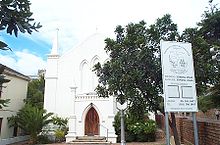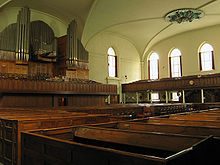- Nederduits Gereformeerde Kerk
-
Nederduits Gereformeerde Kerk Classification Protestant Orientation Reformed Polity Presbyterian Geographical areas South Africa,
Namibia,
Swaziland,
parts of Botswana and Zimbabwe[1]Branched from Dutch Reformed Church of the Netherlands Congregations 1,162[2] Members 1,129,207[2] Official website www.ngkerk.org.za
The Nederduits Gereformeerde Kerk (Dutch Reformed Church, abbreviated NGK) is a Reformed Christian denomination in South Africa. It also has a presence in neighboring countries, such as Namibia, Swaziland, and parts of Botswana and Zimbabwe.[1] Originating in the 17th century from the Dutch Reformed Church of the Netherlands, it is the largest church within South Africa's Dutch Reformed tradition and, along with the Nederduitsch Hervormde Kerk and the Reformed Churches in South Africa, is one of the three sister churches of South Africa. It claims 1.1 million members and 1,626 ordained ministers in 1,162 congregations.[2]Contents
History
Origins in the Cape Colony
When the Dutch East India Company sent Jan van Riebeeck to start a vegetable garden at the Cape of Good Hope in 1652, most of the company's employees were members of the Nederlandse Hervormde Kerk. At first there were no ordained ministers from the church in the Netherlands, to exercise pastoral care, but only a sick comforter. The first minister, Johan van Arckel arrived in 1665, and a consistory was formed but was still subject to the control of the classis in Amsterdam.
In 1688, 200 Huguenot refugees arrived at the Cape. Though at first allowed to hold services in French, they were eventually assimilated into the Dutch-speaking population and became members of the Nederlandse Hervormde Kerk, which had a monopoly in territory controlled by the company. An exception was eventually allowed for a Lutheran church in Cape Town (many of the company's employees were German).
During the Napoleonic Wars, the British occupied the Cape Colony in 1795 to prevent the French from doing so. The French had occupied the Netherlands, and so the link between the Nerderlandse Hervormde Kerk and the Amsterdam presbytery was broken. The first British occupation was temporary, but in 1806 a long-term occupation was undertaken. For the next century, the colony would be under British control. Ministers from the Netherlands were not as willing to serve in what was now for them a foreign country, and the British authorities were not keen to have them. Presbyterian ministers from Scotland were encouraged to serve the needs of the now renamed Dutch Reformed Church in the Cape. The Dutch Reformed Church was semi-established, and the government helped with stipends of ministers.
Expansion and division
The colony had expanded a long way beyond the Cape Peninsula in the preceding two centuries, both to the north and the east, and on the eastern frontier the Dutch farmers came into contact with Xhosa-speaking cattle herders. There were conflicts over grazing and water and cattle rustling across the frontier. The frontier farmers did not like the way the government in Cape Town handled the situation, and the ending of slavery in 1834 was another bone of contention. Afrikaner Calvinism was developing a different worldview to that of the British rulers, and many farmers left the Cape Colony in the Great Trek.
The Dutch Reformed ministers generally tried to discourage them and, as the Dutch Reformed Church was the established church of the colony, did not initially provide pastoral ministry for the emigrant farmers, who eventually formed several independent republics in present day South Africa. Several of the republics in the land beyond the Vaal ("Transvaal") eventually merged to form the South African Republic. Because the Cape Dutch Reformed Church was seen by the trekkers as being an agent of the Cape government, they did not trust its ministers and emissaries seeing them as part of the Cape government's attempts to regain political control. There were also religious divisions among the trekkers themselves. The more conservative ones (known as Doppers) were opposed to singing hymns in church. A minister from the Netherlands, Dirk Van der Hoff, went to the Transvaal in 1853 and became a minister in the Nederduitsch Hervormde Kerk. The Hervormde Kerk was constituted in 1824 whilst still in the Cape, and in 1860 recognised as the state church of the South African Republic, separate from the Cape Church.
 Nederduits Gereformeerde Kerk, Simon's Town/Simonstad.
Nederduits Gereformeerde Kerk, Simon's Town/Simonstad.
There was controversy in the Netherlands over hymn singing as well, and a group had broken away from the Netherlands Reformed Church to form the Christian Reformed Churches. A minister from this group, Dirk Postma, also travelled to the South African Republic and was accepted as a minister of the Hervormde Kerk, but on learning that he and his congregation could be required to sing hymns, he and the Doppers broke away from the state church to form the Gereformeerde Kerk. There were thus now three Dutch Reformed churches in what would become South Africa—the Nederduits Gereformeerde Kerk (the Cape Synod), the Nederduitsch Hervormde Kerk (the state church of the South African Republic), and the Gereformeerde Kerk (led by Postma).
In the Cape Church meanwhile there was more controversy over theological liberalism and conservatism. An evangelical revival led by Andrew Murray tipped the balance away from theological liberalism. One result of the revival was that many young men felt called to the ministry, and a seminary was opened at Stellenbosch. The NG Kerk was thus no longer dependent on getting its clergy from overseas, and as most of the recruits to the ministry had emerged from the revival this was the dominant element. One of its features was a kind of Reformed "Lent", between Ascension Day and Pentecost, a custom that eventually spread beyond the confines of the NG Kerk.
The revival also led to an interest in mission work which led to the establishment of the Dutch Reformed Mission Church for coloureds and the Dutch Reformed Church in Africa for blacks. These were segregated entirely from the white churches, but eventually united to form the Uniting Reformed Church in Southern Africa. The NG Kerk expanded from the Cape Colony, but in Natal and the two inland republics it set up separate synods that were at first loosely federated but later developed a closer relationship.
Following the Anglo-Boer War (1899-1902) the NG Kerk played an important role in reconstruction and resisting the tendency of the British rulers to Anglicise the Afrikaners. As the church ministers became increasingly involved in attempts to uplift the Afrikaner people, they also became politicised, and many became spokesmen for Afrikaner nationalism.
Recent history
In recent years, there have been efforts at reuniting the various branches of South Africa's Dutch Reformed tradition. From 6 to 8 November 2006, 127 representatives of the Reformed Church in Africa, the Uniting Reformed Church in Southern Africa and the Dutch Reformed Church met at Achterbergh near Krugersdorp to discuss the reunification and how this can be realized. The Dutch Reformed Churches Union Act Repeal Act, 2008 of the Parliament of South Africa[3] has one of its objectives as to "remove obstacles in the unification process of the Verenigde Gereformeerde Kerk, Reformed Church of Africa and the Dutch Reformed Churches without legislative intervention".[4]
Doctrine and polity
Theologically, the Nederduits Gereformeerde Kerk is in the Reformed branch of Protestantism. It holds the Bible as authoritative Word of God by which all doctrine is judged. It has three doctrinal standards: the Belgic Confession, the Heidelberg Catechism, and the Canons of Dordt.[5]
The NGK has a presbyterian polity with power divided between synods, presbyteries, and church councils. Church councils govern local congregations and are elected by members of the congregation. Local churches are organised geographically into 146 presbyteries which are further organized into synods. There are nine synods in South Africa, whose borders roughly resemble those of the provinces, and one covering all of Namibia. Every four years, the 10 synods come together and meet as the General Synod. The office of the General Synod is in Pretoria, Gauteng Province.[2]
References
- ^ a b Map of NGK Synods. NGK official English website. Accessed July 14, 2010.
- ^ a b c d "Who We Are". NGK official English website. Accessed July 14, 2010.
- ^ Dutch Reformed Churches Union Act Repeal Act, No. 46 of 2008
- ^ Dutch Reformed Churches Union Act Repeal Bill
- ^ Confessions of the NGK. Official English website. Accessed July 14, 2010.
- Hinchliff, Peter (1968). The church in South Africa. London: SPCK. ISBN 0-281-02277-1.
External links
Categories:- Christianity in South Africa
- Reformed denominations in Africa
Wikimedia Foundation. 2010.


